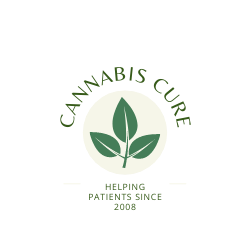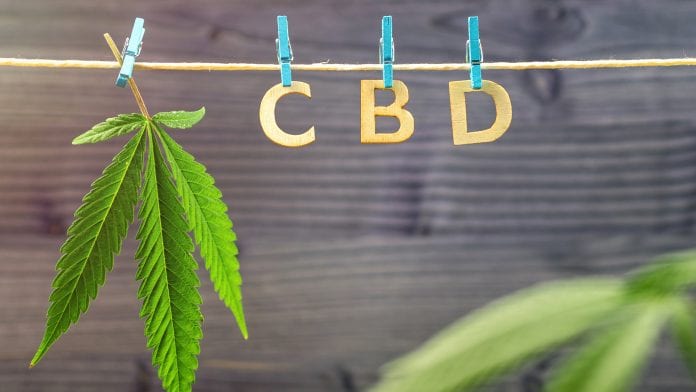CBD Dosage Chart & CBD Concentrations Calculator
Cannabidiol (CBD) is one of many cannabinoid molecules produced by cannabis, second only to THC in abundance.
Since the relaxation of laws surrounding the legality of cannabidiol (CBD), there have been a host of new companies emerging online selling CBD cannabis oil medications. Many shops such as Holland and Barrett, Boots offer it for sale. A simple Google search will inundate you with websites that include Amazon, offering this ‘new miracle cannabis oil medication’.
Lets Start With Percentage Strengh (%)
Medication concentrations are often written as a number followed by a percent sign (e.g., 5%), which implies a specific weight/volume concentration of g/100 units.
For a liquid, the units will be millilitres (e.g., 5% = 5g/100ml).
These are low and furthermore expensive CBD concentrations and is at best an example of clever marketing. Under UK law they are not allowed to claim any medical benefits from its use (which given the low % are practically none).
However, the lack of information available leads patients suffering from serious illnesses to be confused into thinking this is a beneficial product. We receive a lot of email enquiries concerning this matter.
Check out the recommended dosages and use the free online calculator below to accurately measure your CBD dosage (scroll down). The calculator will help you determine the exact dose in your dropper.
When treating serious conditions such as cancer the addition of THC is advised. For most cancers, a 1:1 THC/CBD full-spectrum (whole-plant extract) is recommended.
The original concept that these corporations are now exploiting was the development of a high concentration CBD full plant extract containing trace elements of over 110 different cannabinoids and terpenes, (which the extracts marketed by these corporations don’t have).
The low THC high CBD extract is called Charlotte’s Web and was specifically developed to help children with seizures.
The original Charlotte’s Web initially contained a 20% /30:1 CBD/THC ratio, but the latest version is up to 48:1, with increased potency of around 35% and it is specifically developed for helping children with epilepsy.
Please check out our in-depth information page about how to best and where to buy the best quality CBD Oil Online
Is The CBD Available Online Or Through Health Stores Of Any Medical Use?
The World Health Organisation has declared that Cannabidiol (CBD) should not be a scheduled drug. However, be warned as this has created a completely false impression.
There is a simple answer to this question. YES! CBD extract can be of enormous benefit in treating many conditions: However, this is dose (%) dependant!
The CBD that is commercially available is generally around 5% or less. Even 10% is not of sufficient strength to be considered medical cannabis oil.

Professor Philip McGuire is Professor of Psychiatry & Cognitive Neuroscience at King’s College, London.
He specializes in Neuroscience and has published studies on the effects of cannabinoids.
He is also the main author of a 2017 paper entitled “Cannabidiol (CBD) as an Adjunctive Therapy in Schizophrenia: A Multicentre Randomized Controlled Trial” for the Journal of Psychiatry. In this study, 88 randomised schizophrenia patients were given either a placebo or Cannabidiol (CBD) during a six week period.
This means that half received a neutral substance, while the other half received daily doses of 1000mg of CBD alongside their usual medication. But no one in either group knew which they were receiving.
It was unequivocally shown that psychotic symptoms were significantly reduced in patients that received the CBD treatment. With regards to the availability of the new and legally available CBD cannabis preparations now widely available online and in health stores he states:
“It is easy to get confused about what exactly it is that you’re buying. The products sold in health stores often contain very small amounts of CBD and may also be mixed with other compounds derived from cannabis. In contrast, the CBD that has been found to be effective in clinical trials is pure CBD, and has a much higher dose.”
We are unsure of what Professor McGuire is referring to when he states “pure CBD.” If he is referring to a whole plant extract then he is in agreement with other studies that have found that full spectrum extracts of CBD such as Charlotte’s Web containing trace elements of the other cannabinoids and terpenes are far more effective.
The NHS state on their website:
Many cannabis-based products are available to buy online, but their quality and content are not known. They may be illegal and potentially dangerous.
Some products that might claim to be medical cannabis, such as hemp oil, are available to buy legally as food supplements from health stores. But there’s no guarantee these are of good quality or provide any health benefits.
And although some cannabis-based products are available on prescription as medicinal cannabis, these are only likely to benefit a very small number of patients.
Had the World Health Organization chosen to schedule the drug, it could have prevented physicians from prescribing cannabidiol (CBD) globally. The UK now allows specialists to prescribe CBD medications; but the benefit to patients has been drastically over emphasized and very few people will qualify for a prescription.
What Percent Of Cannabidiol (CBD) Should I Look For?
From November 2018 onwards, your doctor should be able to advise on what strength is most effective for your particular condition.
We recommend a minimum 20% for kids and higher for adults depending on the condition.
There are basically two forms of CBD:
Crystalline isolate. This type of oil has been purified to remove THC and all other cannabinoids, so only CBD remains.
Full-spectrum or whole plant CBD. When CBD oil is referred to as full spectrum or whole plant, the product contains other cannabinoids. This could include trace amounts (0.3 % or less) of THC, along with cannabinol (CBN) and tetrahydrocannabivarin (THCV).
Studies have shown that full-spectrum CBD is more efficient due to its synergistic reactions with the terpenes and minor phytocannabinoids present.
The CBD oils sold for example in Holland & Barrett and other health stores will be crystalline isolate and only contain from 5% to 10% CBD. This can be beneficial when used as a health supplement.
It is nowhere near the strength required to treat any medical condition. Contact us here if you need help sourcing full-plant extract, higher percentage CBD or full spectrum cannabis oils.
Proper CBD oils can contain 40% plus of CBD – the most famous being ‘Charlotte’s Web’. Claims have been made that products like these can alleviate amongst other things mild to moderate mental health problems, such as anxiety, insomnia and depression.
It is important to remember that buying low concentration CBD in its legal form from your local health store is not going to be of benefit for any serious medical condition. The CBD isolate will be a great health supplement, but it will not be in sufficient strength – nor will it contain the full spectrum of other cannabinoids that includes THC which is one of the most important cannabinoids, some would argue above CBD.
How to calculate CBD dosage?
The Accurate Way To Dose Your CBD Oil Medication
CBD Capsules of sufficient concentration are a 100% reliable method of ensuring a consistent dose of CBD.
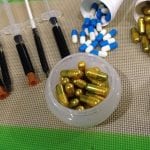
As with most substances, individuals with more body mass will require more CBD to experience its beneficial effect.
A fairly accurate method to determine your CBD dosage is to take 1-6 mg of CBD for every 4.5 kg of body weight. The amount is variable depending on the condition being treated and a patient’s tolerance. There is no potential for overdose.
Because CBD capsules are filled with an exact amount of CBD, they provide a truly accurate way to dose CBD. If your optimal CBD dosage is 25mg, then simply buy a bottle of 25mg capsules of sufficient CBD % concentration. If you have purchased or made a tincture yourself then it becomes slightly more complicated.
How To Measure Your CBD Oil Tincture Dosage
Using a CBD tincture is also a fairly common way to administer CBD.
Generally, the bottle comes with a dropper. Fill the dropper, administer the oil under your tongue, then hold it there for 60 seconds before swallowing. If the dropper is not graduated in ml you are advised to purchase one.
Typically a dropper holds 1 ml of liquid. If you know how many millilitres are in your CBD tincture, you can use this simple calculator to determine how much CBD is in the dropper. For example, a 30ml CBD tincture that has 1500mg of CBD = 50mg of CBD per dropper.
A 30ml CBD tincture (3.3%) that has 300mg of CBD as typically sold online or over the counter will contain just 10mg of CBD per dropper.
Calculate Your CBD Dosage
The chart below that shows an accurate dosage programme and gives the average recommended dosage per condition and severity of symptoms.
Analysis suggests increasing the amount of CBD you take every 3-4 weeks until you obtain symptom relief (inversely, decrease by the same amount if symptoms worsen). Always self-titrate, basically start with a small dose and gradually increase until you find your optimum level.
Additionally, record your daily experiences in a diary so you can accurately calculate your effective dose.
CBD Oil Dosage: Average Milligrams Of CBD & Condition
| AILMENT | MILD | MODERATE | SEVERE |
| ADD/ADHD | 25 | 75 | 155 |
| Alzheimer’s | 20 | 55 | 110 |
| Anxiety | 10 | 35 | 70 |
| Arthritis | 15 | 60 | 110 |
| Autism | 20 | 50 | 150 |
| Bi-Polar Disorder | 20 | 60 | 155 |
| Cancer | 60 | 165 | 310 |
| Crohn’s | 35 | 100 | 195 |
| Dementia | 20 | 55 | 110 |
| Depression | 30 | 80 | 165 |
| Epilepsy | 15 | 40 | 85 |
| High Blood Pressure | 15 | 50 | 95 |
| IBS | 20 | 65 | 125 |
| Inflammation | 10 | 20 | 45 |
| Lupus | 10 | 20 | 60 |
| Lyme Disease | 20 | 75 | 125 |
| Migraines | 10 | 25 | 50 |
| Multiple Sclerosis | 10 | 25 | 55 |
| Myeloma | 50 | 170 | 325 |
| Nausea | 5 | 15 | 35 |
| Neuropathic Pain | 20 | 65 | 130 |
| Pain (General) | 15 | 55 | 105 |
| Parkinson’s | 55 | 165 | 325 |
| Premenstrual Syndrome | 5 | 20 | 40 |
| Rheumatoid Arthritis | 10 | 30 | 55 |
| Schizophrenia | 55 | 150 | 400 |
| Insomnia | 15 | 50 | 105 |
| Tremors | 15 | 50 | 125 |
| Ulcerative Colitis | 20 | 65 | 135 |
These are effective dosages to be taken throughout the day with meals (maximum three times per day/dosage as shown / start at twice a day). Start at the lower recommended dose and continue to incrementally increase – remain at the optimum dose when the desired effects are achieved.
Additional Cannabiniods and Terpenoids
Cannabinoids and Terpenoids occur naturally within the cannabis plant.
Terpenoids comprise a number of related chemical compounds. Within this group, there are many subfamilies, including Terpenes (where the family gets its name), semi-terpene lactones, cannabinoids and others. Among the Cannabinoid family are Phytocannabinoids, made by plants, and endocannabinoids, made by animals.
The Cannabis plant uses enzymes to physiologically direct the production of cannabinoids in the acid form (cannabinoid acids), many of which then further react to form different other cannabinoid acids, neutral cannabinoids (like THC & CBD), and other terpenoids. Many of these secondary reactions occur from the addition of heat, light (commonly UVB) or both.
Little is known about the chemical and physical properties unique to each of these chemical compounds. Currently, the cannabinoids found in the highest concentration (through selective hybridization) and therefore most studied are THC-A, CBD-A, CGB-A, and THCV-A, along with their neutral forms, THC, CBD, CBG and THCV.
Recently strains rich in CBC-A have become more readily available for investigation; it was recently reported in a study that CBC is ten times more potent in managing stress than CBD, requiring 1/10 as much to obtain the same result as with CBD.
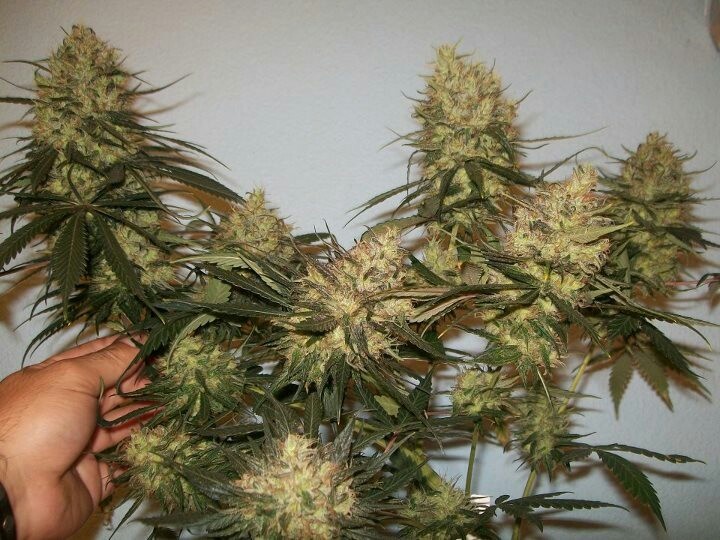
Maturing cannabis plant with buds full of cannabinoids and terpenoids.
Other Cannabis Plant Cannabiniods
THC is the main cannabinoid molecule that is psychoactive.
Yet there are many different cannabinoids in marijuana, all of which are capable of binding to receptors found in our brains. The four additional ones of interest alongside THC and CBD are:
Cannabigerol (CBG)
Cannabigerol is essentially the precursor to THC, CBD, CBC and other cannabinoids. Recently researchers have discovered that CBG itself is potent medicine. CBG alone is not psychoactive. However, it is still the precursor to THC and THCV, the two cannabinoid molecules that are psychoactive.
As with CBD, this cannabinoid inhibits the uptake of a chemical called GABA in the brain. This results in muscle relaxation and anti-anxiety effects.
CBG is also a COX-2 inhibitor. This is the same mechanism that aspirin, ibuprofen and other NSAIDs use to treat inflammation.
Cannabichromene (CBC)
CBC is common to most strains in small amounts. It has medicinal effects similar to CBD but is more effective at treating anxiety and stress-related disorders because it remains in your bloodstream longer, creating a longer-lasting effect.
Researchers are now interested in the effects of this cannabinoid and it has shown itself to be useful as an anti-inflammatory. It’s also anti-bacterial and anti-fungal. CBC is also thought to slow tumour growth and stimulate bone development.
Cannabinol (CBN)
When THC is exposed to oxygen it converts to CBN. This acts as a powerful sedative. CBN shows promise in treating insomnia and nerve pain, and research suggests it has promise for glaucoma patients. The effects of CBN can be quite profound. Unless you are suffering from chronic insomnia or terrible nerve pain you probably don’t want to ingest large amounts of CBN.
Tetrahydrocannabivarin (THCV)
THCV is a cannabinoid very similar to THC. In fact, the two molecules are nearly identical, though the ways they are synthesized in the marijuana plant are different.
THCV is showing promise as an anti-obesity drug. Unlike THC, this particular cannabinoid suppresses appetite. THCV has also been shown useful at reducing tremors resulting from Parkinson’s Disease and other neurological disorders. African Landrace Sativas are high in THCV, as are most of the Haze strains.
Our Own Natural Cannabiniod Receptors
The endocannabinoid system is a vast network of cell receptor proteins with many functions.
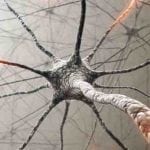
It controls everything from mood swings, cognition, movement, appetite, immune response, sleep, ovulation, and sperm development.
Certain receptors are heavily concentrated in the central nervous system. But, others are found all over the body. They’re in our skin, digestive tract, and even in our reproductive organs.
The brain also contains large numbers of highly specialized cells called neurons. Each neuron connects to many others through structures called synapses. These are sites where one neuron communicates to another by releasing chemical messengers known as neurotransmitters.
Cannabidiol (CBD) & Brain Activity
When these compounds travel through our bloodstream and enter the brain, they influence brain activity by interacting with the appropriate receptors.
Brain receptors are not only sensitive to neurotransmitters produced naturally within the brain, such as dopamine or serotonin but also chemical messengers such as cannabinoids like THC or CBD.
Cannabidiol (CBD) has the ability to influence a wide range of receptor systems in the body, including not only cannabinoid receptors but a host of others.
CBD Effects
It has been shown to exhibit anti-cancer, neuron-protective, anti-inflammatory and analgesic (pain-relieving) properties. It also has a potential therapeutic value in the treatment of disorders such as depression, anxiety and addictions. Cannabidiol (CBD) has also demonstrated its ability to provide a natural anti-anxiety, antiepileptic and antipsychotic effect.
Epilepsy
At the American Epilepsy Society meeting in Philadelphia, researchers presented the results of trials testing the safety and efficacy of cannabidiol. In the biggest study so far, the number of seizures went down by about half, on average, among children who completed the trial.
Benefits for some of the children who took part in the trial continued even after the study was over. Dr Orrin Devinsky, the study’s lead author and a neurologist at the New York University Langone Medical Center reported:
“In the subsequent periods, which are very encouraging, 9% of all patients and 13% of those with Dravet Syndrome epilepsy were seizure-free. Many have never been seizure-free before.”
The data represent a significant step toward the use of cannabis to treat epilepsy, a syndrome that in both adults and children causes debilitating seizures and can be especially difficult to treat.
Interestingly in Devinsky’s three-month trial, 16% of participants withdrew due to adverse side effects or after deciding the treatment was ineffective. Cannabidiol (CBD) is found inside the resin glands (trichomes) of the female cannabis plant. Participants in the studies consumed cannabidiol in the form of daily doses of purified extracts that had been derived from cannabis plants.
The method of administration was perhaps flawed in the studies as a far better route would have been to administer less of the cannabidiol and apply the dosage rectally in the form of suppositories.
See a recent article we wrote here
Adminstration Of Cannabidiol CBD
CBD can be administered in a number of different ways. Different CBD oil products can be taken in a variety of different ways. These include topical application, oral ingestion, sublingual administration, and inhalation. The best method for taking CBD oil very much depends on your medical condition and personal preference.
Further reading
How and where to safely buy RSO medical cannabis oil online
Introduction to Medical Cannabis
Help and Advise
If you need advice or help with Medical Cannabis, please use the contact form provided. We try to answer all emails within 24 hours and are happy to help and advise on all aspects of medical cannabis treatments in complete confidence.
Disclaimer: Please note that whilst we consider ourselves subject matter experts regarding medical cannabis, we are not medical professionals. We are an information resource and there is still limited evidence that medical cannabis can cure all the illnesses we discuss here. We recommend you do as much research as possible, and where practical seek professional medical advice before proceeding with Medical Cannabis oil.
